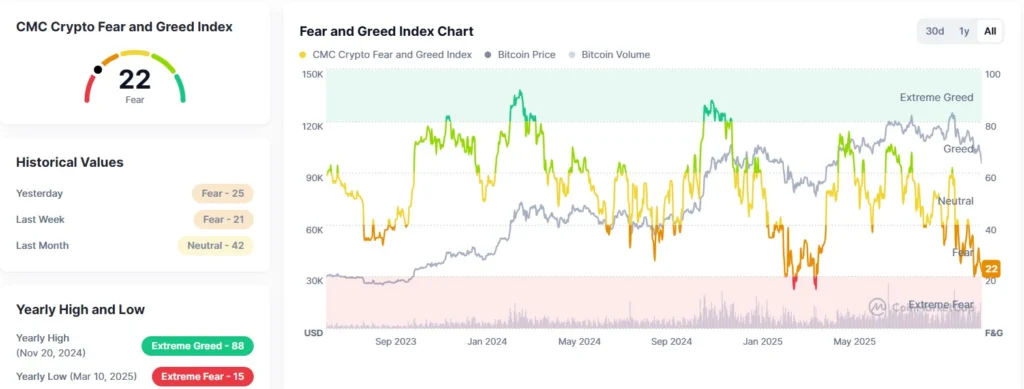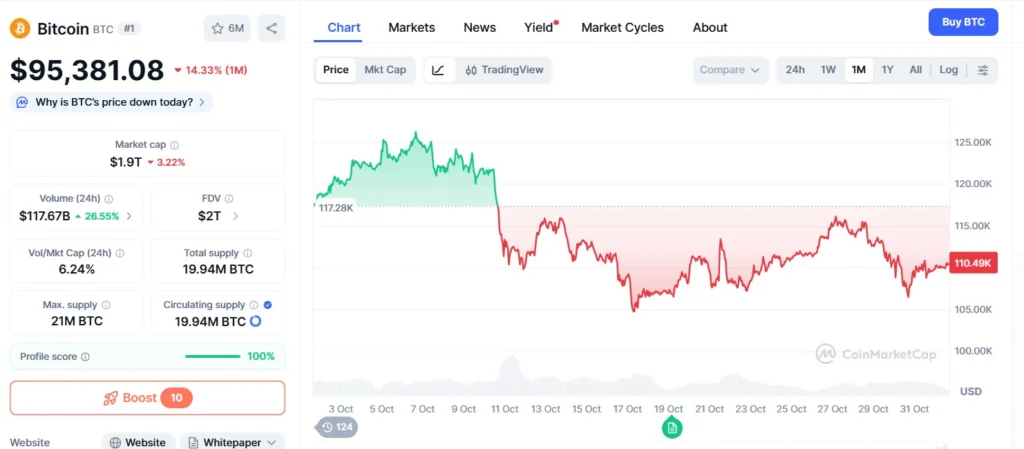
The crypto market has entered a phase marked by sharp tension. Within just a few days, prices dropped significantly, sentiment flipped to fear, and major players started cutting exposure.
The broad sell-off reignited debates, pushed risk indicators into alert mode, and brought back the sense that this cycle may be undergoing a deeper adjustment than expected.
Bitcoin weakened, altcoins were hit even harder, and billions in liquidations revealed how overleveraged the market had become. At the same time, uncertainty around interest rates, ETF behavior, and institutional outflows intensified the retreat.
What stands out isn’t only the speed of the decline, but the sudden shift in investor behavior.
After a heated October, the market now faces an unavoidable question: Is this just a severe correction — or the first signs of a longer period of pressure?
Current Crypto Market Situation (Nov 14, 2025): Sharp Drop, High Fear, and Heavy Deleveraging

Source: CryptoMarketCap
The crypto market is undergoing a strong correction, marked by broad declines, rising fear, and significant capital outflows from major institutional players.
Market Cap and Overall Outlook
- Total market capitalization: between $3.3T and $3.4T, down about 2% in the last 24 hours.
- Bitcoin dominance: ~57%, showing a higher concentration of capital flowing into the leading cryptocurrency.
- General trend: weekly pullback and loss of momentum after the October peak.
These data points signal a deleveraging movement, typical of deeper correction phases.
Sentiment: Fear and Risk Aversion
- The Crypto Fear & Greed Index has returned to fear levels and recently touched “extreme fear.”
- The message is clear: investors are cutting risk and repositioning portfolios.
Reports indicate:
- Higher selling volume from long-term holders.
- October’s rally may have marked the end of the euphoria phase.
Macroeconomic Pressure on the Market
- Expectations around the Fed have cooled: lower probability of rate cuts in December.
- Global capital is shifting toward more conservative assets.
- Bitcoin ETFs remain the main barometer of institutional confidence.
What Phase Are We In?
The crypto market is experiencing a strong correction with traits of a short-term bear phase:
- Bitcoin below $100k
- Steep altcoin losses
- Billion-dollar liquidations
- Rising fear
- Significant ETF outflows
The broader post-halving long-term cycle remains intact, but the current moment is defined by adjustment, caution, and a search for protection.
Bitcoin Falls to Its Lowest Level Since May: Are We Entering a Bear Market?

Source: CoinMarketCap
Bitcoin has dropped to the $95,000 range, its lowest level since May, reigniting the big question dominating the market this week:
Is this just a correction — or the beginning of a true bear market?
The report brings insights from major research firms, including J.P. Morgan and CryptoQuant, highlighting technical signals and on-chain data that help explain the moment.
Bitcoin’s Drop: What’s Happening Now
- BTC touched $94k–$95k, a price zone not seen for months.
- The move triggered alerts among investors and increased overall risk perception.
- The decline pushed the chart closer to key support levels, raising the question: Has the cycle turned?
J.P. Morgan’s Projections
Despite the drop, J.P. Morgan remains optimistic:
- Target of $170,000 for Bitcoin over the next 6 to 12 months.
- The firm argues that the $94,000 region acts as a natural support, as it aligns with the estimated production cost of the network — a historically relevant indicator.
CryptoQuant: Not a Bear Market — For Now
Analyst Ki Young Ju highlights:
1. The $94,000 support is critical
If it breaks decisively, the risk of a bear market increases.
2. The Realized Cap is still rising
The Realized Cap measures network value based on the last transacted price of each BTC.
When it rises, it suggests new capital entering the market — something rare in prolonged downturns.
Other Signals Analysts Are Watching
- BTC is approaching the 365-day moving average, considered an important historical reference.
- Analysts warn that if this support fails, the move could accelerate.
- Some see the moment as a mid-cycle correction, while others fear it may be the start of a more extended downward trend.
What This Means for Investors
For Bitcoin investors, this moment calls for heightened attention:
- Assess exposure and risk levels.
- Track on-chain metrics, not just price.
- Watch key technical supports like $94,000 and the 365-day moving average.
- Avoid emotional decisions — sharp pullbacks can also occur in positive cycles.
XRP, Ethereum, and Solana Plunge and Outpace Bitcoin’s Decline: What’s Happening to Altcoins?

Source: Portal do Bitcoin
While Bitcoin dropped sharply, the leading altcoins — XRP, Ethereum (ETH), and Solana (SOL) — saw even deeper losses, intensifying the market’s risk-off mood. The move highlights a usual pattern during stressful periods: altcoins tend to fall harder than BTC.
Altcoins Drop More Than Bitcoin
According to the report, the three largest non-BTC assets posted steep declines:
- Ethereum (ETH): around –7%
- XRP (Ripple): also near –7%
- Solana (SOL): an even stronger drop, continuing its recent pattern
These losses occurred amid a wave of forced liquidations, with highly leveraged positions being wiped out.
Why Are Altcoins Falling More?
1. Mass liquidations
The market saw more than $1.1 billion in liquidations, hitting assets with higher leverage exposure — typically altcoins.
2. Higher volatility
Altcoins have lower liquidity and react more aggressively to sudden moves.
When the market turns, they fall faster — and harder.
3. Profit-taking
Ethereum, Solana, and XRP had rallied recently. During corrections, investors often take profits on altcoins first before touching Bitcoin.
4. Risk aversion
In uncertain periods, capital shifts away from altcoins toward what’s perceived as “safer” within crypto — Bitcoin itself.
Solana Is the Most Affected: Why?
Solana has posted sharper declines than BTC, ETH, and XRP over the past weeks. Key factors include:
- Higher exposure to leveraged traders
- Heavy speculation in SOL perpetual futures
- A strong pullback after a rapid appreciation phase
- Lower liquidity in order books compared to BTC and ETH
These elements make SOL more vulnerable when the market turns.
What This Signals About the Market
- The market is going through a strong correction, not necessarily the start of a bear phase, but a moment of intense pressure.
- Altcoins have been hit harder, reflecting their more volatile behavior during downturns.
- Bitcoin still drives sentiment, but other cryptocurrencies are absorbing greater losses.
What Investors Should Watch Now
- Liquidation volumes over the next few days
- Key support levels for ETH and SOL
- Bitcoin’s behavior — if BTC stabilizes, altcoins tend to recover
- On-chain and derivatives metrics indicating capital flow
Why Is a McDonald’s Sandwich Exciting the Bitcoin Community? Understanding the “McRib Effect”

Source: Seu Dinheiro
McDonald’s announced the return of the McRib in the U.S. on November 11, 2025 — and surprisingly, this classic sandwich is once again stirring excitement within the Bitcoin community.
The reason? A curious coincidence that gained traction online: in several years, the McRib’s comeback happened close to strong BTC rallies.
But does this “relationship” make any sense — or is it just another crypto meme?
Why This Became a Topic in the Market
The community noticed historical coincidences:
- 2017: McRib returns → BTC surges
- 2020: Relaunch → Bitcoin jumps
- 2021: Another rally coinciding with its comeback
This pattern created what traders jokingly call the “McRib Effect,” a meme widely shared across crypto circles.
Even McDonald’s marketing director mentioned that the McRib has taken on a “new meaning” within the crypto community.
But the correlation doesn’t hold consistently:
- 2018: McRib returns → BTC falls to ~$3,250
- 2022: Relaunch → Bitcoin sinks to ~$15,500
- 2025: After the McRib comeback, BTC dropped about 4%, moving opposite to the “theory”
In short: the McRib is a fun meme — not a market indicator.
Why Does This Generate So Much Buzz?
- Blend of pop culture and crypto
- A meme that’s easy to spread
- A quirky historical coincidence that seems to “predict” BTC moves
- A Light-hearted content in a usually technical market
This kind of narrative resonates because it taps into the cultural side of Bitcoin.
China Accuses the U.S. of Stealing $13 Billion in Bitcoin in Hacker Attack: What Happened and Why It Matters

China has officially accused the United States of stealing 127,272 bitcoins — roughly $13 billion — belonging to the Chinese mining company LuBian, after an alleged hacking incident in December 2020.
The claim was published by China’s state cybersecurity agency CVERC (China National Computer Virus Emergency Response Center).
According to the Chinese report, the U.S. gained access to the assets and moved the bitcoins after years of inactivity, while the American government says the BTC were legally seized during a criminal investigation involving Cambodian businessman Chen Zhi, accused of fraud and money laundering.
What China Is Alleging
- The cyberattack drained more than 127,000 BTC from LuBian, one of the largest Bitcoin miners at the time.
- The coins remained untouched for four years until they were moved in 2024 — for Chinese authorities, this signals state-level action, not common cybercrime.
- China links the incident to businessman Chen Zhi’s case, claiming the U.S. used “investigations” as justification to confiscate the bitcoins.
The United States’ Version
The U.S. government states that:
- The bitcoins were legally seized,
- They were tied to investigations involving electronic fraud and money laundering,
- The movement of BTC in 2024 resulted from judicial procedures, not an international hacking operation.
Who Was LuBian?
Before disappearing in 2021, LuBian controlled about 6% of Bitcoin’s global hashrate.
Its sudden disappearance raised long-standing suspicions of:
- hacking incidents,
- internal disputes,
- or government interference.
The case brings back discussions about cybersecurity in large-scale mining operations.
Why This Case Worries the Crypto Market
This episode exposes three major concerns:
1. Geopolitics is increasingly intersecting with crypto
China and the U.S. already compete in tech, AI, and semiconductors — now they’re clashing over the narrative of who controls large Bitcoin reserves.
2. Cryptoassets can be seized even after years of inactivity
The case highlights that technical control ≠ legal control.
A wallet may have intact private keys and still become the target of state action.
3. Mining companies and large BTC holdings have become strategic targets
Large miners move billions in assets, making them targets for attacks, investigations, and digital intelligence operations.
Lessons for Investors
Even without direct impact on everyday users, the case signals:
- jurisdiction risk,
- the importance of self-custody,
- the need to assess exposure to foreign platforms,
- potential effects on price and market sentiment,
- the growing use of crypto in geopolitical disputes.
Google Reveals AI-Powered Malware Used by North Korea to Steal Cryptocurrencies

A new report from Google Threat Intelligence revealed that groups linked to North Korea are using AI-powered malware to steal cryptocurrencies and target users, exchanges, and companies in the sector. The discovery marks a new level of sophistication, with attackers now using AI to generate malicious code in real time, making traditional detection methods far less effective.
Google’s investigation found that
- North Korean groups are using large language models (LLMs) such as Gemini and Qwen2.5-Coder to generate malicious code during execution.
- The malware uses just-in-time code generation, producing harmful scripts or functions on demand — which weakens conventional antivirus tools.
- The attacks target crypto exchanges, digital wallets, and individual users.
How the AI Malware Works
Two malware families stand out in the report:
1. PROMPTFLUX
- Rewrites its own code through the Gemini API.
- Updates commands and scripts whenever it needs to bypass detection.
2. PROMPTSTEAL
- Uses the Qwen model to create Windows commands on demand.
- Automates unauthorized access to devices and sensitive data.
Other tactics include:
- multilingual phishing creation,
- social engineering targeting exchange employees,
- scripts designed to identify and access self-custody wallets and private keys.
Attack Objectives
The North Korean groups aim to:
- map how digital wallets store data,
- generate scripts to access encrypted storage,
- steal keys, passwords, and cryptoassets,
- craft highly convincing lures for exchange staff.
These attacks target both everyday users and companies operating in the crypto market.
Google’s Response
Google has taken several steps to disrupt the operation:
- Disabled accounts linked to malicious activity,
- Strengthened LLM safety filters to prevent misuse,
- Increased monitoring of LLM APIs and suspicious patterns.
Why This Alarms the Crypto Market
- More advanced threat: AI-driven malware adapts and evolves, making detection harder.
- Direct focus on digital wallets: self-custody users become prime targets.
- More convincing social engineering: AI-generated phishing increases the success rate of scams.
- Exchanges and companies at risk: attacks can compromise internal systems, APIs, and administrative access.
What Users and Companies Should Do
- Keep wallets and apps updated.
- Be cautious with links, attachments, and downloads — even well-written messages.
- Use mandatory 2FA.
- Stick to trusted self-custody wallets like Klever Wallet, which adds extra security layers and isolates private keys.
- Avoid unknown browser extensions — one of the most common attack vectors.


